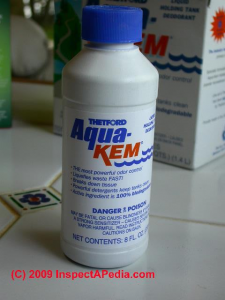As the typical RV’er stands in the “Toilet Chemical” or “Sanitation” aisle in just about any RV supply store they often become overwhelmed by the number of different holding tank treatments sitting on the shelf. There are blues ones, green ones, orange ones, yellow ones. Liquids, tablets, powders and pouches. Big bottles, small bottles, boxes, bags, tubs, jugs, tubes and blister packs. As you take a step closer and start reading the large print, the confusion deepens. They all claim to do basically the same thing!
So, how is one ever expected to make an informed choice?
The simple answer is, “It isn’t easy.” Knowing that answer isn’t going to be of much help, let’s see if we can somehow demystify the buying decision with some basic knowledge of holding tank treatments.
For the sake of simplicity, RV holding tank treatments generally fall into one of two broad categories: Chemical Treatments and Biological Treatments.
A Typical Chemical Treatment
Chemical treatments contain one or more active ingredients that are intended to eliminate odors by essentially halting the waste breakdown process until the contents of the holding tank are emptied to a larger holding facility or a municipal sewer system. The majority of these active ingredients are bacteriostats (suppresses bacterial growth), bactericides (kills bacteria), or masking agents (chemically “locks” odors or attempts to cover them up).
Unfortunately, it has been found that most of these chemicals are toxic to a certain degree and some pose a very real risk to human health and/or the environment. In fact, a number of these chemicals have been under legislative scrutiny for many years due to their potentially harmful effects. The six most commonly used chemicals are: formaldehyde, bronopol, dowicil, glutaraldehyde, paraformaldehyde, and para-dichlorobenzene. All of them have been the subject of various regulations restricting their use in other industries and it is probably just a matter of time before they become regulated in the RV industry.
![]()
A Biological Treatment
![]()
Pure Power comes in Blue or Green
Biological treatments are based on the principal that adding large quantities of beneficial bacteria to a holding tank will “jump start” the waste breakdown process and control odors by excluding the formation of odor-causing “bad” bacteria. A pure biological formula contains no chemicals and is non-toxic to both humans and the environment. As advances are made in the field of microbiology these types of products, such as Pure Power, now have the potential to outperform chemical treatments in every way. It should be noted that enzyme treatments have also been included within this category because they are biological in origin, but they lack the full performance characteristics of a true bacteria based formula.
Summed up in the simplest manner possible, chemical treatments preserve waste and biological treatments break down waste. Both types are meant to control odor, one does it through chemical suppression while the other does it through a natural biological process. Generally speaking, it takes less of a biological product to control odors than is does a chemical product As the rest of the world goes green, so follows the RV industry.
